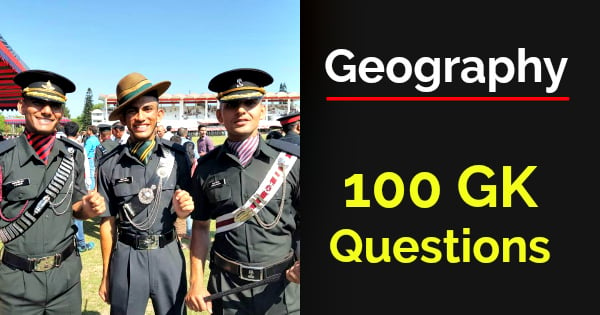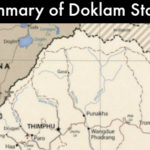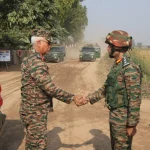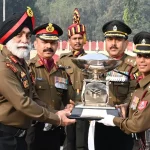The defence examinations of AFCAT, NDA, and CDS are coming soon in upcoming consecutive months. These all have general ability section that checks the general knowledge of the candidates. The section contains questions from all basic theoretical subjects like history, civic, geography, physics, bio etc. Geography is also a part of it. The subject geography is quite interesting and enjoyable.
The questions related to this subjects are mostly asked directly. Below are some of the questions that will help the aspirants in getting the idea of it. Highest biodiversity is seen in – tropical rain forest
100 Geography GK Questions for CDS NDA AFCAT
Q1. Which of the following amidst the following planets has its
orbit closest to Sun –
(a) Mars
(b) Venus
(c) Jupiter
(d) Uranus
Ans: (b) Venus.Venus is the brightest planet in our sky & can sometimes be
seen with the naked eye if we know where to look. It is the solar system’s
brightest planet — yellow clouds of sulfuric acid reflect the sun’s light
brightly & has its orbit closest to sun but only next to mercury.
Q2. In Which among the given states the 1st Synagogue is built
in India –
(a) West Bengal
(b) Maharashtra
(c) Tamil Nadu
(d) Kerala
Ans: (d). The oldest of India’s synagogue buildings can be found in the state
of Kerala, where synagogue construction began during the medieval period.
Whereas Kerala’s 1st Jewish houses of prayer said to be from the eleventh
through the 13th centuries perished long ago as a consequence of natural
disasters, enemy attacks, or the abandonment of buildings when
congregations shifted, as did the earliest confirmed synagogue in Kochandagi
authenticated to 1344 by a surviving building inscription now found in the
courtyard of the Paradesi synagogue in Kochi’s Jew Town, those originating
from the 16th & 17th centuries subsist. These extant synagogues, though
altered over time, include not only the oldest found on the Indian
subcontinent but in the British Commonwealth.
Q3. Which among the given is called the twin of the earth –
(a) Venus
(b) Neptune
(c) Mars
(d) Saturn
Ans: (a) Venus.Venus is the 2nd planet from the sun & a close neighbor to
the earth. Venus is usually one the brightest objects in the sky, which might
be the reason it got its name. It was named after the Roman Goddess of
Beauty. It is quite similar to the planet earth mainly in its size & a few other
characteristics which is why it is often considered the Earth’s twin. However,
surface conditions are not nearly the same making it a quite inhospitable
environment.
Q4. In India, As per the 2001 Census, the female literacy rate is
(a) 54.16
(b) 39.29
(c) 21.97
(d) 29.76
Ans: (a) 54..16 26%, which showed an increase of 11. From comparison to
the 1991 census, the male literacy rate increased to 75.13%.On the other
hand, the female literacy of 53.67% increased at a much faster rate of
14.38%. According to 2011 csnsus, female literacy rate of India is 64.6%.
Q5. The asteroids revolve round the Sun in between:
(a) Mars & Jupiter
(b) Earth & Mars
(c) Jupiter & Saturn
(d) Saturn & Uranus
Ans: (a) Mars & Jupiter.Asteroids, sometimes called minor planets, are small,
rocky fragments left over from the formation of our solar system about 4.
Most of this ancient space rubble can be found orbiting the sun between Mars
& Jupiter.6 billion yrs ago. Asteroids range in size from Ceres, about 952 km
(592 miles) in diameter, to bodies that are less than 1 km across. The total
mass of all the asteroids is less than that of Earth’s Moon.
Q6. In India, as per their 2001 Census, the sex-ratio (females
per 1000 males) is
(a) 934
(b) 930
(c) 927
(d) 933
Ans: (d). As per the Census findings overall Sex ratio in India has declined
over a period of time. It was 946 female per 1000 male in the yr 1951 &
declined to 927 in 1991. In the Census findings (2001), the overall sex ratio
improved by 6 points to 933 females per 1000 males. Highest sex ratio as per
census 2001 was recorded in the state of Kerala with 1058 females per 1000
males. It was lowest in the Daman & Diu with 709 females per 1000 males.
In India, as per their 2011 census, the sex-ratio (females per 1000 males) is
943.
Q7. On Which among the given planets water cycle is available
– (
a) Earth
(b) Jupiter
(c) Mars
(d) Venus
Ans: (a) Earth.The water cycle, also known as the hydrological cycle or H2O
cycle, describes the continuous movement of water on, above & below the
surface of the Earth. The water moves from one reservoir to another, such as
from river to ocean, or from the ocean to the atmosphere, by the physical
processes of evaporation, condensation, precipitation, infiltration, runoff, &
subsurface flow. Although the balance of water on Earth remains fairly
constant over time, individual water molecules can come & go, in & out of
the atmosphere. In so doing, the water goes through different phases: liquid,
solid (ice), & gas (vapor).
Q8. As per 2001 Census, what is the percentage of India’s
population to the world population –
(a) 16
(b) 8
(c) 26
(d) 28
Ans: (a) 16.As per the provisional results compiled quickly for the Census of
India 2001, the population of India at 0:00 hours of 1st March, 2001, stood at
1,027,015,247 comprising of 531,277,078 males & 495,738,169 females.
India’s population comprised about 16 per cent of the global total. Thus, as
widely believed & expected, India became only the 2nd country in the world
after China to officially cross the one billion mark. According to 2011
census, India’s population consists of 17.5% of the world population.
Q9. In a cut motion, when the amount of demand is reduced by
Rs. 100 it is known as
(a) Economy cut
(b) Disapproval of policy cut
(c) Vote on Account
(d) Token cut
Ans: (d).06. When a cut motion is moved to reduce the amount of a demand
by Rs. 100, it is known as ‘Token Cut’. It aims to ventilate a specific
grievance which is within the sphere of the responsibility of the Government
of India. Token cut is symbolic & is humiliating for the Government. 1.
Q10. One of the pairs not matched correctly is
(a) Shimla–Himachal Pradesh
(b) Dehradun – U.P.
(c) Drajeeling – West Bengal
(d) Panchmarhi – M.P.
Ans: (b) Dehradun – U..P. Dehradun is the capital city of the state of
Uttarakhand in the northern part of India. Situated in the Garhwal region, it is
236 km north of India’s capital New Delhi & is one of the “Counter
Magnets” of the National Capital Region (NCR) being developed as an
alternative core of growth to help ease the migration & population explosion
in the Delhi metropolitan area. Dehradun is situated in the Doon Valley on
the foothills of the Himalayas nestled between two of India’s mightiest rivers
– the Ganges on the east &
Q11. Brightest planet in our solar system is
(a) Mercury
(b) Venus
(c) Mars
(d) Jupiter
Ans: (b) Venus.Venus has the highest albedo of any planet in our solar
system. It owes its reflective ability to the fact that it’s blanketed with clouds.
Venus is so bright partly as it reflects over 70 per cent of sunlight striking it.
Sunlight bouncing from these clouds is what makes Venus so bright.
Q12. A high growth rate of population is characterised by
(a) high birth & low death rates
(b) high birth & high death rates
(c) low birth & low death rates
(d) low birth & high death rates
Ans: (a) high birth & low death rates.Population growth is the change in a
population over time, & can be quantified as the change in the number of
individuals of any species in a population using “per unit time” for
measurement. High birth & low death rates add to the population base
considerably as while the base remains intact, the erosion due to deaths is
hampered.Ans: (d).
Q13. Which of the following one of the following is called a red
planet –
(a) Mercury
(b) Venus
(c) Mars
(d) Jupiter
Ans: (c) Mars.Mars is the 4th planet from the Sun & the 2nd smallest planet
in the Solar System. Mars is a terrestrial planet with a thin atmosphere,
having surface features reminiscent both of the impact craters of the Moon &
the volcanoes, valleys, deserts, & polar ice caps of Earth. Named after the
Roman god of war, it is often described as the “Red Planet”, as the iron oxide
prevalent on its surface gives it a reddish appearance.
Q14. In India, population density is defined as the number of
persons
(a) per lakh square mile
(b) per square mile
(c) per lakh square kilometre
(d) per square kilometre
Ans: (d).. yr 1998) Commonly this may be calculated for a county, city,
country, another territory, or the entire world. The world’s population is 7
billion, & Earth’s total area (including land & water) is 510 million square
kilometers (197 million square miles. According to 2011 census population
density of India is 382.
Q15. Which of the following one of the following planets has no
moon –
(a) Neptune
(b) Mars
(c) Mercury
(d) Pluto
Ans: (c) Mercury.Mercury & Venus are the only two recognized planets in
our solar system without moons. However, there are many, many planets in
the universe & a significant portion of these, if our solar system is assumed
representative of at least a significant portion of the universe’s planetary
systems likely have no moons.
Q16. What is the stage in the population cycle in which India is
classified on the basis of its demographic characteristics –
(a) High stationary stage
(b) Early expanding stage
(c) Late expanding stage
(d) Declining stage
Ans: (c) Late expanding stage.The demographic transition model is a chart
showing the different stages of a country‘s population‘s birth rate & death
rate. India is in stage 2 of the demographic transition model right now with a
high birth rate of 23 per 1000, & a decreasing death rate of 7 per 1000. There
are 5 stages, with each progressively going further into the future. A biproduct
of this, is a high rate of natural increase with India‘s being at 1.5%.
In the late expanding or the 3rd stage of the demographic cycle the birth
tends to fall but the depth rate declines still further & the population
continues to grow as the births exceeds deaths, e.g. India, China, Singapore,
etc.
Q17. The surface temperature of the sun is estimated as
(a) 12000 °C
(b) 6000 °C
(c) 18000 °C
(d) 24000 °C
Ans: (b) 6000 °C.The surface of the sun is called the photosphere. It has dark
spots called sunspots which are the only solar activity observable by the
naked eye. The photosphere is 340 miles thick & it’s temperature s range
from 5,500°C to 6,000°C.
Q18. Match List I with List II & select the true answer using
the codes given below the lists: List-I
A. Assam
B. Dadra & Nagar Haveli
C. Lakshadweep
D. Sikkim
List-II
1. Silvassa
2. Gangtok
3. Dispur
4. Kavaratti
A B CD
(a) 3 1 4 2
(b) 3 2 1 4
(c) 4 1 3 2
(d) 1 2 4 3
Ans: (a) 3 1 4 2.Silvassa is the capital of the Indian Union Territory of Dadra
& Nagar Haveli. Gangtok is situated in the eastern Himalayan range, at an
altitude of 5,800 feet (1,800 m). Gangtok is the capital & largest town of the
Indian state of Sikkim. Dispur is the capital of Assam, in northeast India.
Dispur has existed as a locality on the outskirts of Guwahati, took its place as
the capital of Assam in 1973. Kavaratti is the capital of the Union Territory
of Lakshadweep in India. Kavaratti is a census town in addition the name of
the atoll upon which the town stands.
Q19. The light from the Sun reaches the Earth in about—
(a) 8 minutes
(b) 8 2nd s
(c) 10 2nd s
(d) 10 minutes
Ans: (a) 8 minutes.Light travels at 186,000 miles a 2nd at the Earth is 93
million miles to Sun on average.33 minutes for light from the Sun to reach
Earth. This works out as 8. On average, it takes energy between 10,000 &
170,000 yrs to leave the sun’s interior & then be emitted from the surface as
light. Sunlight, in the broad sense, is the total frequency spectrum of
electromagnetic radiation given off by the Sun, particularly infrared, visible,
& ultraviolet light. On Earth, sunlight is filtered through the Earth’s
atmosphere, & is obvious as daylight when the Sun is above the horizon.
Q20. As per the latest estimates, the literacy rate (% of
population) in India is
(a) 65%
(b) 63%
(c) 67%
(d) 68%
Explanation: *) Literacy in India is key for socio-economic progress, & the
Indian literacy rate grew to 74. The level is well below the world average
literacy rate of 84%, & India currently has the largest illiterate population of
any nation on earth.04% in 2011 from 12% at the end of British rule in 1947.
The 2011 census, however, indicated a 2001-2011 decadal literacy growth of
9.2%, which is the slower than the growth seen during the previous decade.
There is a wide gender disparity in the literacy rate in India: effective literacy
rates (age 7 & above) in 2011 were 80.9% for men & 64.6% for women. The
census provided a positive indication that growth in female literacy rates
(11.8%) was substantially faster than in male literacy rates (6.9%) in the
2001-2011 decadal period, which means the gender gap seems to be
narrowing.
Q21. The four largest planets of the Solar System in decreasing
size are
(a) Mercury, Jupiter, Saturn & Neptune
(b) Jupiter, Mercury, Saturn & Uranus
(c) Jupiter, Saturn, Uranus & Neptune
(d) Jupiter, Mercury, Saturn & Neptune
Ans: (c) Jupiter, Saturn, Uranus & Neptune.The diameter of Jupiter is
1,42,984 km, Saturn: 1,20,536 km ,Uranus: 51,118 km, & that of Neptune is
49,528 km.
Q22. What percentage of Indian population is below the official
poverty line –
(a) 30% to 35%
(b) Below 30%
(c) Above 35% but below 40%
(d) Between 40% & 45%
Ans: (b) Below 30%.The Planning Commission, in March 2012, released the
latest poverty estimates for the country showing a decline in the incidence of
poverty by 7. 28.3 per cent over the past five yrs & stating that anyone with a
daily consumption expenditure of Rs.35 & Rs. 22.42 in urban & rural areas
respectively is above the poverty line. The all-India Head Count Ratio (HCR)
has declined by 7.3 percentage points from 37.2% in 2004-05 to 29.8% in
2009-10, with rural poverty declining by 8.0 percentage points from 41.8% to
33.8% & urban poverty declining by 4.8 percentage points from 25.7% to
20.9%.
Q23. The largest planet in our solar system is
(a) Jupiter
(b) Mars
(c) Saturn
(d) Mercury
Ans: (a) Jupiter.Jupiter is the 5th planet from the Sun & is the largest planet
in the solar system. It also contains two & a half times the mass of all the
other planets combined. If Jupiter were hollow, more than one thousand
Earths could fit inside. It has a mass of 1.9 × 1027 kg & is 142,800
kilometers (88,736 miles) across the equator.
Q24. Which of the following State of India has the largest
percentage of poor –
(a) Chhattisgarh
(b) Bihar
(c) Orissa
(d) Jharkhand
Ans: (b) Bihar.Poverty in India is widespread, with the nation estimated to
have a 3rd of the world’s poor.7% of the total Indian people fall below the
international poverty line of US$ 1. In 2011, World Bank stated, 32.25 per
day (PPP) while 68.7% live on less than US$ 2 per day. Odisha is the state
with the max. proportion of poor at 57.2 percent in 2004-05. Odisha is
followed by Bihar, Madhya Pradesh (MP), Uttar Pradesh (UP) &
Maharashtra, according to data by the Planning Commission of India. While
over half the population in the states of Odisha & Bihar operates below the
poverty line, Madhya Pradesh is just shy of 50 percent.
Q25. Which of the following is the hottest planet in the Solar
System –
(a) Saturn
(b) Jupiter
(c) Venus
(d) Uranus
Ans: (c) Venus.Mercury is closer to the sun, but the atmosphere on Venus
actually makes it hotter. The atmospheric pressure of Venus is also about 90
times greater than that of Earth. Even on the night side, the temperature
doesn’t drop by much (comparatively) as of the carbon dioxide, about 95%,
atmosphere.
Q26. The number of females per 1000 males in India’s
population (Census 2001) is
(a) 929
(b) 900
(c) 933
(d) 945
Ans: (c) 933.As per the 2001 Census, Sex ratio (the number of females per
1000 males) for India was 933 females per 1000 males, which was an
improvement of 6 points over 927 recorded in 1991 Census. Haryana
reported the lowest sex ratio of 861 among the major states. Like the 1991
Census, the highest sex ratio (1058) was reported in Kerala. The number of
females per 1000 males in India’s population (census 2011) is 943.
Q27. Which among the given statements is correct –
(a) Pluto was discoverd by Clyde Tombaugh in 1930
(b) Pluto is not a Planet now
(c) Pluto has been given the number 134340
(d) All of the above
Ans: (d). LDC, DEO & PA/SA Exam, 06.2016 TF No.12. 3441135) Pluto
was discovered by clyde Tombaugh in 1930. According to International
Astronomical Union (IAU) on August 24, 2006 Pluto is considered as dwarf
planet. As per the definition, there are currently eight planets & five dwarf
planets known in the solar system. The five dwarf planets are Pluto, Ceres,
Eris, Make make & Haumea. Pluto has been given number 134340.
Q28. According to India’s Report of 2001 percentage of
population living in rural areas is
(a) 72
(b) 70
(c) 74
(d) 80
Ans: (a) 72.As per the 2001 Census of India, in a total population of 1027
million in India, about 742 million (or 72.8%) lived in urban areas.2%) lived
in rural areas & 285 million (or 27. There had been an increase of 2.1
percentage points in the proportion of urban population in India during 1991-
2001. According to 2011 census, population of rural India is 31.1% & urban
India is 68.9%.
Q29. The Milky Way Galaxy was 1st observed by
(a) Maarten Schmidt
(b) Galileo
(c) Marconi
(d) Newton
Ans: (b) Galileo.The Milky Way is the galaxy that contains our solar system.
Observational evidence for the Milky Way being made up of distant stars 1st
came when Galileo pointed his telescope in the direction of the Milky Way,
observing a big amount of faint stars. This name derives from its appearance
as a dim “milky” glowing band arching across the night sky, in which the
naked eye cannot distinguish individual stars.
Q30. Which of the following one of the following states of India
records the highest sexratio –
(a) Karnataka
(b) Kerala
(c) Maghalaya
(d) Tamilnadu
Ans: (b) Kerala.Kerala has the highest sex ratio; while Haryana has the
lowest sex ratio among states & Daman & Diu has the lowest In all states &
territories.
Q31. Among the following, the celestial body farthest from the
Earth is
(a) Uranus
(b) Saturn
(c) Neptune
(d) Pluto
Ans: (c) Neptune.Pluto, formal designation 134340 Pluto, is the 2nd -mostmassive
known dwarf planet in the Solar System (after Eris) & the tenthmost-
massive body observed directly orbiting the Sun. Like other members
of the Kuiper belt, Pluto is composed primarily of rock & ice & is relatively
small, approx. Originally classified as the ninth planet from the Sun, Pluto
was recategorized as a dwarf planet & plutoid owing to the discovery that it
is only one of several big bodies within the Kuiper belt. one-6th the mass of
the Earth’s Moon & one-3rd its volume. It has an eccentric & highly inclined
orbit that takes it from 30 to 49 AU (4.4–7.4 billion km) from the Sun. This
causes Pluto to periodically come closer to the Sun than Neptune. Pluto gets
as close as 4.44 billion km. But its orbit is so elliptical that it gets out to a
distance of 7.38 billion km. In fact, there are times in Pluto’s orbit when
Neptune passes it. Then Neptune really is the farthest planet from the Sun.
Q32. The birthrate measures the number of births during a yr
per
(a) 1000 population
(b) 100 population
(c) 10000 population
(d) 100000 population
Ans: (a) 1000 population.The birth rate is typically the rate of births in a
population over time. The birth rate along with mortality & migration rate are
used to calculate population growth. The rate of births in a population is
calculated in several ways: live births from a universal registration system for
births, deaths, & marriages; population counts from a census, & estimation
through specialized demographic techniques. The crude birth rate is the
number of births per 1,000 people per yr. The total (crude) birth rate (which
includes all births)—typically indicated as births per 1,000 population—is
distinguished from an age-specific rate (the number of births per 1,000
persons in an age group).
Q33. The moon is showing its same face to the earth as
(a) Its rotation & revolution are opposite
(b) It is not rotating about its own axis
(c) Its periods of rotation & revolution are the same
(d) Its rotation is faster than its revolution
Ans: (c) Its periods of rotation & revolution are the same.As it is “tidallylocked”
to the Earth. Imagine a person who walks around a center pole, but
shifts their body so they are always facing it as they walk. The Earth’s gravity
slows down the moon’s rotation, so that it rotates at the same speed as it
revolves around the Earth.
Q34. During which decade did the population of India record a
negative growth rate –
(a) 1911–21
(b) 1921–31
(c) 1941–51
(d) 1931–41
Ans: (a) 1911–21.Negative Population growth rate or decline in population
can refer to the decline in population of humans. It can be used to refer to
long-term demographic trends, as in urban decay or rural flight, but it is also
commonly employed to describe big reductions in population due to violence,
disease, or other catastrophes. It is a term usually used to describe any great
reduction in a human population. During the decade of 1911-1921,
population decreased by 7 lakhs. Epidemics like plague, cholera, malaria &
famines accounted for this decline. Plague epidemic in 1918 took a toll of
140 lakh human lives.
Q35. Which of the following is the coldest among the following
– (
a) Earth
(b) Mars
(c) Pluto
(d) Mercury
Ans: (c) Pluto.Until it lost its planetary status in 2006, Pluto was the coldest
with an estimated surface temperature between -235 & -210 degrees Celsius.
Pluto has always had the ‘honour’ of being the coldest planet with an average
temperature between -360 to – 400 degrees Fahrenheit. But Pluto has now
been relegated the status of a Dwarf Planet. This is as it is so far away from
the sun: it is over 40 times further from the sun than planet Earth. Pluto also
has no internal heat source & it even orbits in a ring of ice debris.
Q36. The most literate union territory in India is
(a) Lakshadweep
(b) Delhi
(c) Chandigarh
(d) Pondicherry
Ans: (a) Lakshadweep.According to India’s census facts 2011, Kerala comes
up as the most literate state in the country with 94. The state of Bihar is the
least literate with 61.0 percentage of literacy rate.8% of literacy rate. As
regards to Union Territories, Lakshadweep shows the highest literacy rate of
91.8%. The least literate Union Territory in India is Dadra & Nagar Haveli
with a literacy rate of 76.2%.
Q37. Which among the given does not belong to the solar
system –
(a) Comets
(b) Asteroids
(c) Planets
(d) Nebulae
Ans: (d).
Q38. Jawahar Tunnel, the largest in India is situated in the
State of
(a) Maharashtra
(b) Jammu & Kashmir
(c) Karnataka
(d) Himachal Pradesh
Ans: (b) Jammu & Kashmir.Jawahar Tunnel or Banihal Tunnel, named after
the 1st Prime Minister of India, was constructed for round-the-yr surface
transport by Mr. Barsel (both were German) between 1954 & 1960. Alfred
Kunz & C. Situated between Banihal & Qazigund, This tunnel facilitates
round-the-yr road connectivity to Srinagar From Jammu.
Q39. The number of staellites of the planet is Mercury is
(a) 1
(b) 0
(c) 2
(d) 16
Ans: (b) 0.The nearness of Mercury to the massive gravity influence of the
Sun is the likely reason that no natural satellites are present, although it is
possible that one or more may have existed in the past.
Q40. Diu is an island off
(a) Goa
(b) Daman
(c) Gujarat
(d) Maharashtra
Ans: (c) Gujarat.Diu Island is lying off the south coast of Gujarat’s
Kathiawar peninsula, separated from the mainland by a tidal creek. Diu is
originally a part of union territory of Daman & Diu.
Q41. Which of the following planet is called evening star –
(a) Mercury
(b) Mars
(c) Venus
(d) Jupiter
Ans: (c) Venus.Venus “overtakes” the Earth every 584 days as it orbits the
Sun. As it does so, it changes from the “Evening Star”, visible after sunset, to
the “Morning Star”, visible before sunrise.
Q42. Which among the given states as per-census, has the
highest & lowest sex ratio respectively –
(a) Himachal Pradesh & Punjab
(b) Kerala & Haryana
(c) Meghalaya & Bihar
(d) Tamil Nadu & Uttar Pradesh
Ans: (b) Kerala & Haryana.Like the 1991 Census, the highest sex ratio
(1058) had been reported in Kerala. According to 2011 census, Highest sex
ratio–Kerala (1084) Lowest sex-ratio–Haryana (879). Haryana reported the
lowest sex ratio of 861 among the major states.
Q43. The outermost layer of the Sun is called
(a) Photosphere
(b) Chromosphere
(c) Corona
(d) Lithosphere
Ans: (c) Corona.The outermost layer of the sun is the corona. The white
corona is a million times less bright than the inner layers of the sun, but is
many times larger. Only visible during eclipses, it is a low density cloud of
plasma with higher transparency than the inner layers. A corona is a type of
plasma “atmosphere” of the Sun or other celestial body, extending millions of
kilometers into space, most easily seen during a total solar eclipse, but also
observable in a coronagraph. The word “corona” itself derived from the
Latin, meaning crown. The high temperature of the corona gives it unusual
spectral features
Q44. Census of population in India is done after every
(a) 05 yrs
(b) 10 yrs
(c) 07 yrs
(d) 02 yrs
Ans: (b) 10 yrs.The Indian Census is the most credible source of information
on Demography (Population characteristics), Economic Activity, Literacy &
Education, Housing & Household Amenities, Urbanisation, Fertility &
Mortality, Scheduled Castes & Scheduled Tribes, Language, Religion,
Migration, Disability & many other socio-cultural & demographic data since
1872. The census is a decadal compilation of data about India’s demography
& associated features..
Q45. Which of the following is the 2nd nearest star to the Earth
after the Sun –
(a) Sirius
(b) Vega
(c) Proxima Centauri
(d) Alpha Centauri
Ans: (c) Proxima Centauri.As the nearest star from our Solar System,
Proxima Centauri is a prime candidate for future interstellar travel & space
colonization missions.24 light-yrs distant inside the G-cloud in the
constellation of Centaurus. Proxima Centauri is a red dwarf star about 4. It
was discovered in 1915 by Robert Innes, the Director of the Union
Observatory in South Africa, & is the nearest known star to the Sun, although
it is too faint to be seen with the naked eye. As of the proximity of this star,
its distance from the Sun & angular diameter can be measured directly, from
which it can be determined that its diameter is about one-seventh of that of
the Sun. Proxima Centauri’s mass is about an eighth of the Sun’s, & its
average density is about 40 times that of the Sun.
Q46. Match the following: Sea Ports (A) Bhatkal (B) Alleppey
(C) Kakinada (D) Tuticorin States 1. Kerala 2. Tamil Nadu 3.
Karnataka 4. Andhra Pradesh ABCD
(a) 4 3 2 1
(b) 1 3 4 2
(c) 3 1 4 2
(d) 2 4 1 3
Ans: (c) 3 1 4 2.Bhatkal, also known as Batecala in some Portuguese
historical texts is a port town in Uttara Kannada district of Karnataka.
Kakinada is a city & a municipal corporation in the Indian state of Andhra
Pradesh. Alappuzha, also known as Alleppey, is a city in Alappuzha District
of Kerala state of southern India. It is also the headquarters of East Godavari
district. Thoothukudi, also known as Tuticorin, is a port city & a Municipal
Corporation in Thoothukudi district of the Indian state of Tamil Nadu.
Q47. Biggest planet of solar system is
(a) Mars
(b) Earth
(c) Saturn
(d) Jupiter
Ans: (d). Jupiter is the biggest planet in our Solar System. It is the largest by
mass, volume, & surface area among other statistics. Here are the critical
measurements of Jupiter in addition a few other interesting facts about the
planet & other bodies in the Jovian system.
Q48. Which of the following is the largest state of India,
population-wise, according to 2001 census –
(a) Bihar
(b) Maharashtra
(c) Uttar Pradesh
(d) West Bengal
Ans: (c) Uttar Pradesh.As per the 2001 Census, Uttar Pradesh continued to be
the most populous state in the country with 16.42 percent) & Bihar (8.17
percent of India’s population followed by Maharashtra (9.07 percent). In fact
the population of Uttar Pradesh (166 million) was more than the estimated
population of Pakistan. According to 2011 census, most population-wise
states are 1. Uttar Pradesh– 19,98,12,341 2. Maharashtra – 11,23,74,333 3.
Bihar – 10,40,99,452 4. West Bengal – 9,12,76,115
Q49. Pulsars are
(a) stars moving away from Earth
(b) stars moving in the direction of the Earth
(c) rapidly spinning stars
(d) high temperature stars
Ans: (c) rapidly spinning stars.The word “pulsar” is a contraction of
“pulsating star. It blasts out in a giant explosion known as a supernova, the
most powerful & violent event in the universe. A pulsar is formed when a
massive star collapses exhausts its supply of fuel. Without the opposing force
of nuclear fusion to balance it, gravity begins to pull the mass of the star
inward until it implodes. In a pulsar, gravity compacts the mass of the star
until it forms an object composed primarily of neutrons packed so tightly that
they no longer exist as normal matter. As the star collapses, it begins to spin
more rapidly in what is known as the conservation of angular momentum.
The process is similar to that of an ice skater pulling their arms in close to
spin faster. What is left behind is a rapidly spinning ball of tightly packed
neutrons inside an iron shell..
Q50. Which among the given is correctly matched –
(a) Arunachal Pradesh – Guwahati
(b) Assam – Itanagar
(c) Tripura – Agartala
(d) Nagaland – Shillong (FCI Assistant Grade-III Exam. 5.02.2013
(Paper-1)
Ans: (c) Tripura – Agartala.Agartala is the capital of the Indian state of
Tripura & is the 2nd -largest city in North-east India after Guwahati in terms
of municipal area in addition population. It lies on the bank of Haroa River &
is situated 2 km from Bangladesh. It is located in North-east India. Agartala
has temples & palaces. As per 2011 census, Population of Agartala city has
exceeded 5,12,000. Agartala has a monsoon influenced humid subtropical
climate with big amounts of rain almost all yr. The city experiences long, hot
& wet summers, lasting from April to October.
Download 1000+ Geography Questions PDF

Best SSB Book –> Let’s Crack SSB Interview
Best AFCAT Book –> Let’s Crack AFCAT
Best EKT Book -> Let’s Crack EKT
To crack SSB and AFSB Interview get “Let’s Crack SSB Interview” Book from Flipkart. Trusted by thousands of defence aspirants
Also Download Helpful eBooks:
Read More –













